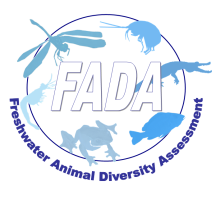About the Freshwater Animal Diversity Assessment Project (FADA)

The Freshwater Animal Diversity Assessment (FADA) is an informal network of scientists specialized in freshwater biodiversity.
Documents:
- list of FADA members (including international initiatives)
- Poster of the FADA book
The first product of FADA was a global assessment of freshwater animal diversity published in a special issue of Hydrobiologia (595) in 2008:
Several projects have completed assessments of freshwater biodiversity but focused mainly on leading 'better-known' groups such as fish, or identified keystone species and/or endemic freshwater systems for conservation purposes. A few global initiatives have gathered available information on biodiversity of inland waters. However, our purpose is to complete these existing projects by providing an expert assessment of animal (species and generic) diversity in the continental (fresh)waters of the world by focusing on taxonomic and biogeographic diversity.
The main three objectives for each animal group are:
- providing the current numbers of known species and generic diversity globally;
- identifying the known distribution (by zoogeographic region), and to identify possible gaps;
- highlighting the main areas of endemicity.
Because these extant patterns are the result of historic processes, the project emphasizes phylogenetic aspects and processes
of evolution and speciation. In addition, information on human related issues such as economical and medical uses, threats,
conservation issues, are included when pertinent.
Our assessment includes non-marine aquatic species of inland waters in two categories:
1. The 'real aquatic species' accomplish full, or part of their lifecycle in or on the water.
2. The 'water-dependent' ('paraquatic') species show close/specific dependence on aquatic habitats
(eg., for food or habitat).
For each group, so-called limno-terrestrial species are in principle not included in the total numbers but
are discussed in the chapter when relevant. Regarding interface environments: euryhaline species in estuaries are only
included if they show a genuine tolerance to freshwater (< 3 g/l) and only the non-marine fauna from
Anchialine caves and transitional environments is included.
More..


